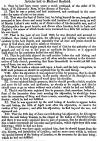|
Richard Bayfield, alias Somersam.
Richard Bayfield was a monk in the abbey at St Edmunds, Bury [ Bury St
Edmunds, Suffolk] and another who was converted to the Protestant
faith through contact with godly people. His conversion began when two
London brickmakers, Master Stacy and Master Maxwell in the company of Dr
Barnes [ burnt with Garret and Jerome in 1540], stayed at the abbey where Bayfield was chamberlain and responsible
for attending on visitors. He was much taken with the conversations he had
with them all and was given a copy of the New Testament in Latin by
Barnes. The others gave him a New Testament in English, and two other
books – The Wicked Mammon and The Obedience of a Christian Man.
Within a space of about two years Bayfield had firmed up his opinions
but and come to the attention of his superiors who had punished him
by gagging and whipping him before placing in the stocks. It was a
further nine months before he was allowed out to accompany Dr Barnes to
Cambridge. From there he went to London and was kept by Maxwell and Stacey
for a while before proceeding abroad. He became acquainted with William
Tyndale and John Frith and was a successful book seller of their work and
other Reformers both in France and England.
Despite becoming a `wanted` man,
Bayfield made regular trips between England and the continent conveying
many copies of the New Testament and works of the other reformers.
Such was the volume that it drew questions from Bishop Tunstall who had
previously tried to short circuit distribution by buying up stocks and
burning them. The authorities now focused on capturing Bayfield. On a trip back to England he went to the home of a
merchant in Bucklesbury, London, but he was betrayed by an Edmund Peerson, a
priest known to him. In a deposition that Peerson made he declared that at
about 3 pm on 14th October (1533) Bayfield had encountered him
at St Edmunds in Lombard street, where he was standing at the parsonage
gate in the company of two other priests, James Smith and Miles Garnet.
They exchanged banter about how many Christian men he had saved. Bayfield
was then followed to a bookbinders in Mark Lane. there he was seized and taken to the Lollards Tower (at St Pauls) before being
thrown into the coal house. His treatment was particularly harsh wherein
he was triple tied at the neck. waist and legs, standing upright
against a wall, and manacled in chains. An effort was made to get him to
reveal the names of his customers but he stood firm to his beliefs and
gave nothing. Three times he was arraigned before the prelates led by
Stokesley Bishop of London, in St Pauls and asked to abjure. On 10
November 1531 a list of 11 articles or charges were laid
against him preparatory to the usual proceedings for declaring him a
heretic. The articles are illuminating and show how active Bayfield had
been

At his appearance before the
prelates on Friday 10 November 1531 he admitted being a monk since
1514 and had taken orders as a priest in 1518. He admitted bringing into
the country during the past eighteen months ” a great number of
every sort”. Further questioning revealed the wide range of both his
own reading, and the nature of the books that he had been distributing.
These included:
The New Testament in Latin and English.
An old book by Thorp.
John Frith`s Purgatory.
The practice of Prelates.
The Parable of the wicked Mammon.
The Obedience of a Christian Man.
The Sum of Scripture.
The Dialogue between a Ploughman and a Gentleman.
Frith`s Dialogues.
Five Books of Moses.
A response by Tyndale to Sir Thomas More.
The Primer in English.
The Psalter in English.
The full schedule of books that had been
imported included works by Luther. Oecolampadius, Zwingli, Lambert,
Melanchthon, Bucer, Felinus, and Capito. ( Listed in Foxes
Martyrs,(Townsend 1846) vol iv, p 684-5)
The following day questioning continued
when he revealed the frequency of his journeys bringing books into the
country. He admitted doing so in the summer of 1530 landing the books at
Colchester and bringing some to London for distribution. He also brought
books in at St Catherine`s Wharf London which were taken from him by the
Chancellor. At the preceding Easter (April 1531) he had brought books in
through Norfolk and taken them to London.
Having confessed to the other charges it
was inevitable that he was pronounced a relapsed heretic, formally
degraded, and physically struck down by the bishop`s staff of office. This
was done at a staged gathering in St Pauls, Monday 20 November 1531 in the
presence of the prelates and the Earl of Essex, the Mayor of London, and
the Sheriffs of London who had been specially summoned to attend. The
purpose for their presence materialised when Bayfield was committed
directly into their custody without any writ from a civil court, only a
bishop`s letter (as allowed under an enactment of Henry IV.) Interestingly
the summons to the Sheriffs, dated 19 November, declares that Bayfield was
a relapsed heretic etc before he had been declared so publicly at
St Paul`s. But then he was convicted from the moment he was seized.

Bayfield was taken the same day to
Newgate where he was slowly burnt at the stake. It is said that he took
half an hour in the flames to die
“and when the left arm
was on fire and burned, he rubbed it with his right hand, and it fell from
the body, and he continued in prayer to the end without moving.”
His crime: being party to
criticism of the Church of Rome.
Thomas Garret
, book importer, d 1540
18/07/2011
|